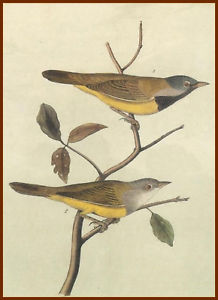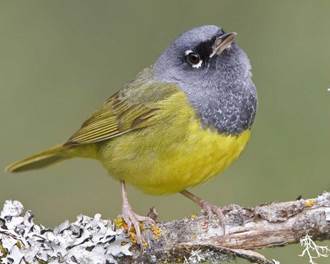Came the spring with all its splendor. All its birds and all its blossoms, All its flowers, and leaves, and grasses. Henry Wadsworth Longfellow.
his is a small songbird of forest edges and dense brush. It’s about 4.5 inches long, has yellow underparts and olive upperparts, pinkish legs, and a small pointed bill. Males have a gray hood and a broken eye ring while the females are gray-brown with a yellowish wash on the throat. These birds, like most warblers, are insect eaters so you will not see them over the winter when they migrate south. They show up in the springtime, timed with the hatch of insects so they can support their nestlings. This bird breeds from Alaska and the Yukon to California and central New Mexico.

They are very similar to the eastern morning warbler but their ranges do not overlap – thus you don’t have to spend time thumbing through the field guide. The highest winter density of MacGillivray’s warbler is found in the Mexican cloud forests, but not much is known about its overall migration patterns. It is known as a shy and elusive species. Warblers are known for their often complex songs – MacGillivray’s song sounds like tree-tree-tree-tree-sweet-sweet. Or swee-eet, swee-eet, swee-eet, peachy, peachy.
You decide: https://www.youtube.com/watch?v=ZSnnindag3s
John James Audubon (a friend) named it in honor of the Scottish ornithologist William MacGillivray who wrote the 5-volume series History of British Birds (1837-1851). But later it was discovered that it had been earlier named by John Townsend (of Townsend’s warbler and solitaire) in honor of William Tolmei, a physician who was attached to the Hudson Bay Company. Thus, one man is honored in the common name and the other in the Latin species name.
Interestingly, Tolmei was based at Fort Nisqually in 1833 when there was an earthquake and the notes from his journal are the first written recording of such an event in the Puget Sound region. T
he genus Oporonis is combined from the Greek opora for autumn and ornis for bird as it was seen more often during the fall migration.
They will build nests of coarse grass, stems, and barks in the forks of trees or shrubs within 2-5 feet from the ground. They typically lay four eggs that hatch within 13 days. I recently started hearing them again this spring in my backyard in NE Seattle. Of course they are way up in the tree tops so you never get to see them but once you know it they have a pretty distinctive call and you know spring time is here in the PNW – sort of.
